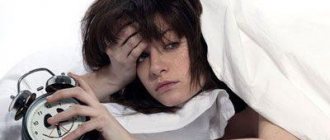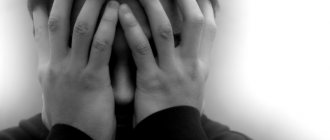Exploding heads syndrome
This sleep disorder does not have a fairy tale ending.
Kleine-Levin syndrome is a rare neurological disorder associated with excessive sleep, strange behavior and confusion. About 70 percent of people who suffer from this syndrome are teenage boys. The syndrome occurs in waves when the person sleeps most of the day and night, but between such episodes he appears completely healthy. Although the cause of the disorder is unknown, some scientists believe it occurs due to dysfunction of the hypothalamus, which helps regulate sleep and body temperature. To date, there is no treatment.
A unique tram stop has appeared in Poland: it is decorated with a herbarium
Disappointment in first love: what obstacles children will face at school
My husband is cheating on me? I gave my husband a voice recorder and found out what he thought about me
This disorder occurs during the deep sleep phase, when a person suddenly wakes up, startled by a sudden, loud noise. Its range ranges from crashing plates to explosions. To the person who hears them, it seems that they occur either very close to the head, or inside the skull itself. In this case, the person does not feel pain. Doctors don't know what causes exploding head syndrome, and it hasn't been shown to cause any serious illness.
Sound sleep: what will happen to the body if you start drinking tea instead of coffee
The car does not freeze even in the cold thanks to a life hack from a neighbor trucker
After adding lemon zest to food, I noticed positive changes after a week.
Treatment of hallucinations
Hallucinations are a manifestation of the underlying disease. Depending on this, treatment consists of anticonvulsants, antidepressants, psychotropic drugs, neurosurgical and otolaryngological methods, as well as drug addiction therapy. Visions associated with normal sleep and wakefulness are not subject to specialized treatment.
Psychiatric patients should be treated by a psychiatrist. Psychotropic drugs are prescribed: tizercin, haloperidol, relanium. Single, transient episodes can be attributed to short-term factors: sleep disturbance, overwork, meditation. You can do without treatment.
However, if the general condition cannot recover on its own, you need to consult a therapist or psychologist. It is necessary to determine the cause and create a treatment plan.
Causes
Several reasons have been identified that provoke the development of hypnagogic hallucinations. They depend on the gender of the patient.
In adults
The development of hypnagogic hallucinations in this category of people is most common. They may be related to:
- development of nervous tension caused by sleep disturbances, prolonged stress, neurosis, depressive disorder and anxiety;
- consumption of substances that have a toxic effect on the nervous system. These may include alcoholic beverages, medicines and drugs;
- mental illness. The most common among them are various variants of schizophrenia, epilepsy or narcolepsy;
- organic pathologies. This group of causes includes a large number of diseases affecting the nervous system. These are inflammations of an infectious nature, atherosclerosis, impaired blood flow in the brain, tumor processes of a benign and malignant nature.
In children
Children of childhood experience hypnagogic conditions against the background of prolonged stressful situations and an unfavorable psychological environment.
What are hallucinations?
Deception in the process of perceiving the surrounding reality - this is how we can explain what hallucinations are. The patient’s psyche is capable of independently recreating non-existent sounds, objects, etc. Most often, this condition occurs in those who abuse alcohol. Many addicted people suffer from various mental disorders, which may be accompanied by the appearance of non-existent phenomena and pictures.
This is observed in drug addicts and those who take various psychotropic drugs. They all experience hallucinations quite often. But such a disorder in the process of perception can occur even in a healthy person under the influence of various reasons.
Causes of hallucinations
Various illnesses often lead to the appearance of hallucinations. The most common ones include the following:
- Syphilis of the brain. With this disease, a person hears voices and sharp sounds, and also sees unpleasant visual images.
- Alcoholism and drug addiction. They contribute to the appearance of incomprehensible images, scary visions, and intrusive sounds. Many patients fall into a delusional state, which is accompanied by a feeling of fear.
- Decompensation of cardiovascular diseases. Accompanied by frequent changes in emotional state, unjustified anxiety and a feeling of fear. After some time, non-existent visions join such symptoms. All these signs disappear completely after the circulatory system is restored.
- Rheumatic diseases of the heart and blood vessels. They contribute to fatigue, increased irritability, intolerance, sleep disturbances and periodic hallucinations.
- Malignant brain tumors. The strength of manifestation of non-existent visions is influenced by the degree of exhaustion of the body, the use of narcotic drugs for treatment, and the intensity of the toxic effect of the tumor.
- Infectious diseases. They often contribute to the appearance of hallucinations. For example, malaria and typhus provoke a sharp increase in temperature, headaches and delirium.
Most often, mental illness and abnormalities in the functioning of the nervous system lead to the appearance of non-existent visions.
These include:
- schizophrenia;
- epilepsy;
- various psychoses;
- pre-infarction condition;
- delirium tremens in alcoholism.
Impaired perception of the surrounding reality in such diseases occurs as a result of a malfunction of the central nervous system and brain. You can get rid of this condition with the help of psychopharmacological drugs.
Hallucinations are caused by taking narcotic and psychotropic drugs: heroin, morphine, amphetamine, marijuana. This is also facilitated by toxic substances when inhaled: gasoline and various solvents, synthetic adhesives, dyes and varnishes. Sometimes non-existent visions occur in people with a special reaction to taking certain medications: antihistamines, tranquilizers, antidepressants, psychostimulants, anticonvulsants, narcotic analgesics.
In addition, there are sleep hallucinations, which are events that occur during sleep. They are often confused with dreams. The person is not sure whether he is asleep or awake. This condition occurs when going to bed and after waking up.
Symptoms of hallucinations
Hallucinations can have various symptoms:
- visual: the appearance of visual images of faded or colored scenes;
- auditory: the patient hears sounds that are not there - calls, words, voices that can praise, scold, order;
- olfactory: a person perceives rotten, putrid odors in their absence;
- gustatory: a feeling of a disgusting or pleasant taste in the mouth that does not exist;
- tactile: a person touches non-existent objects;
- bodily: the patient experiences unpleasant sensations in the body - bursting of bubbles in the intestines, passage of current, touching the body.
Night terrors
The horrors you see in your dreams can be very different. For some people, this is a murderer who is chasing them with an axe; for others, their night terrors may see themselves naked in a public place. The common thing is that at some point a person suddenly wakes up. However, when night terrors go beyond occasional irritation, you may develop a sleep disorder.
Stress and sleep deprivation are common problems in this disorder. In severe cases, counseling or sedatives may be needed to calm the anxiety underlying the bad dreams. However, to banish night terrors, most people will only need to relax and go to bed on time.
Classification
Hallucinations must be divided into two main groups:
- true or hallucinations developing against the background of the absence of stimulating factors. The occurrence of this event is not associated with the action of external stimuli. The actions that take place are similar to reality, so they do not cause excessive anxiety in patients;
- pseudohallucinations. The events that happen to the patient do not relate to the reality around him and cause increased anxiety. The patient’s sensations are intrusive and occur against the person’s thoughts.
Depending on which analyzer is used, the hallucination can be:
- visual. This manifestation is the most common and is characterized by the detection of simple shapes such as a zigzag, light flash or spot;
- olfactory. A person is able to smell non-existent odors. Most often these are unpleasant hallucinations when falling asleep with the smell of rotten meat, feces or rotten food;
- functional. It is accompanied by a feeling of motor activity in one of the limbs or the whole body;
- visceral. The patient is bothered by various sensations inside the body that cannot exist. This may be the movements of parasites, the feeling of a foreign body located in the body;
- tactile. The condition is expressed by the appearance of non-existent touches to the surface of the body;
- vestibular. This type of hallucination is manifested by disorientation in space with a feeling of falling or spinning;
- auditory. Patients hear non-existent voices, various information, calls to action. Auditory hallucinations during sleep can have varying intensity, which in some cases frightens the patient;
- complex. Such nocturnal hallucinations are the most complex, as they involve several analyzers at once. Most often these are auditory and visual images.
Types of hallucinations and their symptoms
Illusions and hallucinations can be classified according to different criteria. The most extensive and accurate description is based on the types of feelings affected:
- Visual – vision of a fantastic object or image. There are color hallucinations - a change in the color of the surrounding reality, the brightness of true colors changes greatly.
- Auditory - a deception of the senses, which is accompanied by imaginary voices, ringing, sounds, whispers, knocking, which are difficult to remove and impossible to find their source.
- Olfactory – sensations of foreign odor. Most often, the patient imagines a putrid, fetid aroma from food and things.
- Tactile – illusions associated with tactile sensations. It seems to the patient that he can touch unreal objects, the touch of imaginary objects. Some tactile illusions are characterized by the sensation of a foreign object in the body or under the skin.
- Gustatory – a change in the usual taste, the presence of an unexplained irritant in food. Products can acquire both pleasant and unpleasant tastes. Against the background of such hallucinations, obsessive ideas about poisoning may arise.
- Hypnopompic or hypnagogic are hallucinations that occur before falling asleep or waking up. They are placed in a separate category because they do not have a complex cause.
All visions can be divided into hallucinations and pseudohallucinations. The first are illusions that naturally fit into the world around us. They become part of the events taking place. This could be the sound of footsteps in the next room, the image of an alien in the window, or a strange smell from the food you are eating. Each vision fits into the situation so accurately that it becomes difficult for the patient to realize where is reality and where is fiction. Often fantastic hallucinations seem to the patient much more real than existing objects. Pseudohallucinations include voices in the head, any images that are not visualized in any way and do not adapt to current events. These may be foreign bodies under the skin, in the body, which, in the patient’s opinion, pose a direct threat. A person has no doubt about the reality of his visions and sensations, while for many patients they look like a “set-up”, for example, voices in the head are “rigged with special devices”, “caused by medications” given by doctors. Their hallucinosis is accompanied by delusions and obsessive thoughts. Symptoms become more complicated, making subsequent treatment difficult.
Illusions can be divided into simple and complex. Simple hallucinations affect one sense organ. The patient either hears sounds, or sees an image, or feels a taste or smell. During complex hallucinations, the picture becomes three-dimensional and realistic. The fantastic object begins to talk, touch, and emits a smell. If a person experiences constant complex hallucinations, it means that he is under the influence of a serious illness, and visions are just symptoms. What should he do, where should he start treatment, which specialist should he contact?
Symptoms
Hypnagogic hallucinations are manifested by the development of non-existent events during sleep. Most often they bother patients during the period of falling asleep or the first hours of sleep.
The condition is characterized by:
- sense of smell;
- feeling of falling or being in a state of flight;
- sounds;
- visual images. Hypnagogic images are vivid and the patient clearly describes the object seen.
Unlike dreams, the patient can accurately describe hallucinations upon awakening and will perceive everything that happens as if it happened in reality.
Conscious hallucinations that appear systematically begin to bother the patient. These events are real in nature, which raises doubts among others.
Symptoms of hallucinations
It is difficult to describe “typical” hallucinations, as they vary in duration, quality, and how patients experience them. Some visions last only a few seconds. However, some patients with Charles Bonnet syndrome experienced visual hallucinations for several days. In people taking psychotropic drugs, they lasted several hours.
There is not always a connection between cause and emotional response. Only 13% of patients rate them as pleasant, and 30% find them terrible. Most patients with narcolepsy, alcoholic hallucinosis, or PTSD report unpleasant, frightening hallucinations.
They occur after emotional stress, stress, medications, severe fatigue or mental illness, during periods of consciousness. Appear as visions, sounds, voices, tactile sensations, smells, sounds. Patients suffering from dementia and schizophrenia experience fear of hallucinations. Visions are possible in healthy people after nervous overload, fatigue, or caused intentionally by taking drugs or meditation.
Diagnostic methods
A single occurrence of hypnagogic hallucinations does not require contacting specialists and prescribing treatment.
The main part of the diagnosis is a conversation with a specialist. The doctor finds out the time of occurrence of hallucinations, predisposing factors, medical history, and also asks the patient to describe in detail what happened.
The patient needs to keep a diary in which he will indicate the time of the attack, the events that occurred, as well as provoking factors.
Additional methods that are necessary to exclude organic pathology include:
- computed tomography. A highly sensitive technique makes it possible to detect structural changes at the initial stages of development in the brain or its choroid plexuses;
- Dopplerometry. Ultrasound examination allows you to scan the vessels of the brain and exclude occlusions;
- electroencephalography. The technique is based on identifying an area in the brain with increased functional activity.
Sleepy hallucinations
We're used to seeing strange things in our dreams, but what if we're awake at the time? So-called hypnagogic hallucinations occur during the transition from wakefulness to sleep, or vice versa. People report hearing voices, experiencing phantom sensations, and seeing a person or strange object in their room. People often see insects or animals crawling on walls.
During the rapid eye movement phase, the muscles of the body become motionless. This temporary paralysis keeps us from acting during sleep so that we cannot harm ourselves. Sometimes, however, paralysis persists even after the person wakes up. You know you're awake and want to start moving, but you can't.
How to recognize hypnagogic hallucinations in children?
As you know, hallucinations are a perception without a real object , that is, these are imaginary visions, sounds, voices, smells, etc. The peculiarity of hypnagogic hallucinations is that they occur before falling asleep, usually with the eyes closed, in a dark field of vision. Most often they are visual, but can also be accompanied by sounds. Usually the same vivid, sometimes fantastic, images of false perception are repeated before every night, and sometimes (very rarely) before falling asleep during the day.
Children may identify their hypnagogic hallucinations as dreams. Most often, the waking perception of false images in real space turns into dreams, when the same frightening creatures appear in nightmares. Children do not always talk about their hallucinations in detail. They can simply say that they are scared, that they are afraid to sleep without their parents. Such hallucinations, indeed, may not appear if, for example, they feel mothers and parents with their bodies. Because of fears of seeing scary images, a child may sleep clinging to his mother. Such children sleep so lightly because of their anxiety that they can immediately wake up as soon as their mother leaves them. No amount of persuasion or persuasion that one should be afraid has any effect on children suffering from hypnagogic hallucinations. How can they not be afraid if scary images are the same reality for them, like their mother, like everything around them?
Frequent “heroes” of hypnagogic hallucinations are monsters, monsters, snakes, dead relatives, “come to life” scary images from cartoons, huge spiders, and aliens. The peculiarity of these hallucinations is that all these false images are very vivid, and children literally see them side by side before their eyes. When they describe them, they often say that these fears are in their eyes. This is most likely due to the fact that scary images appear immediately as soon as they close their eyes in the dark or when they find themselves alone in a room.
Sometimes, due to the fear of hypnagogic hallucinations, a child may fall asleep instantly, but have too much sound or very restless superficial sleep. Often in children such problems are accompanied by persistent nocturnal enuresis, repeated throughout the night. It happens that due to panic fears of hypnagogic hallucinations in a child, one of the parents is forced to sleep with him until he is 15–16 years old.
For parents whose children are afraid to go to bed, complain of nightmares, scream, cry or pee during sleep, it is important to ask in detail about their fears. If children tell their parents or loved ones about their unusual fears, then first of all you should not blame them for this (“What are you making up?”) or deny the fears (“Look, there’s nothing!”). If children are convinced that there are no monsters, monsters, etc., then they simply stop sharing that they have certain fears, because they begin to feel bad: “Mom says that there is nothing, but I see it!?”
It happens that children talk in some detail about their fears, but parents somehow get used to their complaints and stop paying attention to them, especially if doctors, and sometimes psychologists (!), convince them that there is nothing wrong that the child has ordinary fantasies, he makes up everything, that everything will soon pass. Indeed, such fears and hallucinatory experiences sometimes pass with time, but more often than not they do not disappear without a trace. They can greatly reduce immunity, develop into anxiety states, various psychosomatic and neurosis-like manifestations.
The cause of hypnagogic hallucinations can be some kind of trouble during pregnancy and childbirth (prolonged or rapid labor, entanglement in the umbilical cord, a long dry period after the water breaks, Rh incompatibility, etc.), severe psychotrauma.
Hypnagogic hallucinations in most cases respond well to psychotherapy, so it is best to consult a psychologist or psychotherapist. In most cases, you can cope with this problem in several, or even in one session.
Tags: anxiety, child psychologist, psychological problems, fear, child, children
Treatment
The choice of treatment method will depend on the underlying cause of the disease, as well as the age of the patient.
If organic changes are detected in the organs of the central nervous system or blood vessels, treatment can be surgical or medicinal.
In adults
The frequency of detection of organic pathology, as well as mental illnesses, is higher in adults. Also, this category of people is more susceptible to stress.
If the cause of the disease is nervous overstrain, preference is given to medications that have an antidepressant and calming effect.
As a result of treatment, the body's response to stress decreases, sleep improves with an increase in its duration, anxiety and nervous agitation decrease. These medications are taken under strict medical supervision.
It is important for the doctor to regularly assess the patient’s well-being and, if necessary, change the drug or completely stop it.
In children
Treatment of hypnagogic hallucinations in children must be carried out using non-drug methods. This is associated with an increased risk of overdose and side effects, as well as withdrawal symptoms.
The child is consulted with a psychotherapist or psychologist, who, during a conversation, identifies the main cause of such disorders. In some cases, a course of treatment is required.
Treatment methods
Hallucinations caused by triggers (psychotropic substances, poisoning, hypnosis, drugs) are treated by getting rid of the harmful effects (the triggers themselves).
The only exceptions are those situations in which external factors led to changes in the body or provoked withdrawal symptoms.
Hallucinations against the background of psychotic disorders are treated by correcting the underlying pathology that provoked the perception disorder. For this purpose, antipsychotics are used.
If the underlying pathology cannot be treated (senile dementia), then therapy is aimed at stopping the acute phase of hallucinations.
If hallucinations were caused by taking drugs or alcohol, the patient must undergo a course of rehabilitation .
Scheme
How to treat pathology? What medications will help?
Treatment for hallucinations is individual therapy. Drugs are selected based on the clinical picture, type of hallucinations, underlying pathology and emotional state of the patient.
The list of mandatory measures includes:
- taking medications according to an individual regimen;
- isolation of the patient during the acute period (directly hallucinations);
- individual psychotherapy for the patient’s rehabilitation and return to normal life.
Nightmares
Nightmares can affect not only the person who sees them, but also the people who are close to him. Unlike night terrors, which occur during REM sleep, nightmares occur during slow sleep, usually at the beginning of the night. They are most common in children. During a nightmare, a person may feel feverish and may suddenly sit upright with his eyes open, although he is not actually aware of what is happening around him.
You can go to school without washing your face: mom shares unusual labor-saving methods
Start playing sports: how to be happy without a relationship
Angel: a man saved many people who decided to die with just one phrase
The cause of nightmares is a mystery, but irregular sleep, fever and stress can trigger them. Fortunately, nightmares usually disappear as the child grows up.
Conduct disorder during REM phase
If sleep paralysis is an example of immobility, then the so-called REM behavior disorder is too much activity during sleep. Sometimes the brain sends the wrong signals to the body and people act out during sleep. They may scream, fight, or even get out of bed and run. After waking up, they usually remember their dreams, but forget what they did.
Sure, you can have the willpower to deny yourself sweets throughout the day, but how do you control it when you're sleeping? People who have a nocturnal eating disorder empty the refrigerator while they sleep and have little memory of the event the next morning. Some people may injure themselves while cutting food or cooking it on a hot stove. Others eat raw ingredients, such as frozen foods or regular butter.
The disorder is poorly understood, but, like sleepwalking, it manifests itself during the slow-wave sleep phase. Drugs that increase dopamine levels may help stop unconscious nighttime snacking, doctors say.












